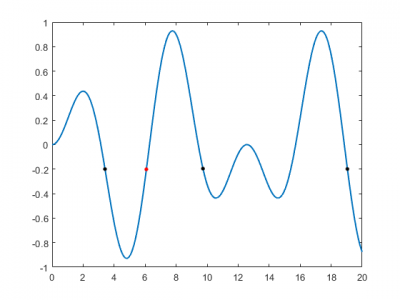labelThresholdEvents.m
Class: Function
Description: Takes in the procTracks data structure and detects events based on the times at which the values of a user-specified field rise above (or drops below) a user-specified threshold. Applies a refractory period, preventing new events from being detected before the given quantity drops below (or rises above) a second user-specified threshold. This can help to suppress spurious events that result from noisy data.
Author: Oliver J. Meacock
- labelThresholdEvents.m
function procTracks = labelThresholdEvents(procTracks,tgtPop,tgtField,startThresh,endThresh,eventLabel) %LABELTHRESHOLDEVENTS labels times at which a given track-associated %quantity either goes above or below a given threshold with an integer %label. % % INPUTS: % -procTracks: Track data output by the tracking module. % -tgtPop: If population assignment has been performed, this variable % can be used to specify which of the populations you wish to % restrict event detection to. Can be left empty if you wish to apply % it to all tracks. % -tgtField: String defining the name of the field of procTracks you % wish to apply threshold detection to. Can refer to any field, % provided it is indexed by time and is one-dimensional (so 'x' and % 'vmag' are permissible, but 'start' and 'length' are not). % -startThresh: The value of the track-associated data that needs to % be breached for an event to be detected. Track then enters a % 'refractory' state, where the value needs to drop above/below % endThresh for a new event to be detected. % -endThresh: Defines the value at which the track-associated % quantity is released from its refractory state. If endThresh > % startThresh, it is assumed that an event starts when the given data % drops below startThresh and that the refractory period ends when it % rises above endThresh. If endThresh < startThresh, the opposite is % true. % -eventLabel: The integer you wish to use to label this set of % events. % % OUTPUTS: % -procTracks: Equal to the input procTracks, but either with the % 'event' field updated, or (if not already present) added, with the % appropriate events marked. % % Author: Oliver J. Meacock, (c) 2020 if startThresh >= endThresh transType = 'up'; %Events are when you go from low to high elseif startThresh < endThresh transType = 'down'; %Events are when you go from high to low else error('Thresholds do not appear to be numerical.') end %Needed to ensure you don't overwrite pre-existing event data in procTracks %later if isfield(procTracks,'event') preFlag = true; else preFlag = false; end for i = 1:size(procTracks,2) currList = procTracks(i).(tgtField); if preFlag currEvt = procTracks(i).event; %Get pre-existing event list for this track (if it exists) else currEvt = zeros(size(procTracks(i).x)); %Want to make sure we're using the maximal possible length of the event list (need to avoid using e.g. vmag, which is one shorter than maximum as it is from a differential). end %Want to do processing only if the tgtPop variable is empty OR there is %a target population, the population field exists, and the current %track is part of the target population if isempty(tgtPop) proceed = true; elseif ~isempty(tgtPop) && isfield(procTracks,'population') if procTracks(i).population == tgtPop proceed = true; else proceed = false; end elseif ~isempty(tgtPop) && ~isfield(procTracks,'population') warning('Population specified, but field not present in procTracks. Proceeding without splitting by population...') proceed = true; end if proceed currInd = 1; refState = false; %Whether you are in the refractory period or not switch transType case 'up' evtSwitch = find(diff(currList > startThresh) == 1); refSwitch = find(diff(currList < endThresh) == 1); case 'down' evtSwitch = find(diff(currList < startThresh) == 1); refSwitch = find(diff(currList > endThresh) == 1); end evtList = []; while proceed %I.e. while there are still events to test futureEvts = [0,evtSwitch' > currInd]; futureRefs = [0,refSwitch' > currInd]; if ~refState && sum(futureEvts) > 0 %If event is permitted, detect next and switch to refractory state currInd = evtSwitch(diff(futureEvts) == 1); evtList = [evtList;currInd]; refState = true; if sum(refSwitch' > currInd) == 0 proceed = false; end elseif refState && sum(futureRefs) > 0 %If event is not permitted, detect next refractory period end and switch to 'excitable' state currInd = refSwitch(diff(futureRefs) == 1); refState = false; if sum(evtSwitch' > currInd) == 0 proceed = false; end else proceed = false; end end currEvt(evtList+1) = eventLabel; end procTracks(i).event = currEvt; end
Example usage:
%Make some artificial data with multiple peaks of different heights dt = 0.01; t = 0:dt:20; y = sin(x).*sin(x/4); procTracks(1).times = round(t/dt); procTracks(1).y = y; %Detect event class 1 when y rises above -0.2 (must drop below -0.6 for %subsequent detections) procTracks = labelThresholdEvents(procTracks,[],'y',-0.2,-0.6,1); %Detect event class 2 when y drops below -0.2 (must rise above 0.05 for %subsequent detections procTracks = labelThresholdEvents(procTracks,[],'y',-0.2,0.05,2); %Plot results plot(procTracks.times*dt,procTracks.y,'LineWidth',1.5) hold on %Red dots indicate events of class 1 plot(procTracks.times(procTracks(1).event == 1)*dt,y(procTracks(1).event == 1),'r.','MarkerSize',12) %Black dots indicate events of class 2 plot(procTracks.times(procTracks(1).event == 2)*dt,y(procTracks(1).event == 2),'k.','MarkerSize',12)
Example output:
